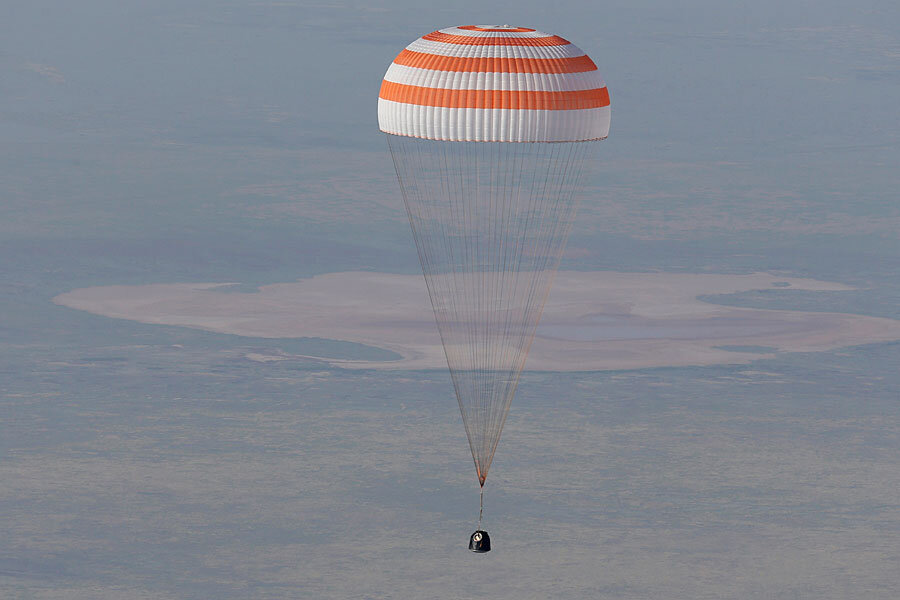International Space Station: How serious are Russia’s threats?
Loading...
The safe landing in Kazakhstan Wednesday of a Russian Soyuz capsule returning three astronauts from the International Space Station suggests that for all the thunder and fury coming from Moscow about the future of the station, operations are continuing on a business-as-usual basis, at least for now.
On Tuesday, Russian Deputy Prime Minister Dmitri Rogozin announced that the country would consider ending its participation in the space-station program in 2020; would prohibit the US military's use of a rocket motor that powers the Atlas V, one of two launch workhorses for defense and intelligence satellites; and would close down global-positioning-satellite monitoring stations in Russia unless it was allowed to build comparable monitoring stations in the US for its navigation satellites.
All of these threatened steps are in response to sanctions the US and Europe have imposed on influential Russians – including Mr. Rogozin – over Russia's annexation of Crimea and its efforts to destabilize eastern Ukraine.
Tuesday's announcement represents a shot across the bow for the US space program, says Roger Handberg, a political scientist at the University of Central Florida in Orlando who specializes in space and defense policy.
But, if no further actions or statements come out of Moscow "indicating that this is going to get pushed seriously, then I think we'll just go on as we are," he says.
NASA has no other choice, he says, and in some ways, neither do the Russians.
In January, the US agreed to extend its participation in the space station program to 2024 instead of 2020, an extension that US partners sought after studies showed that the modules, especially the most recent additions from Europe and Japan, would be capable of lasting at least until 2024, and likely well beyond. The moves Rogozin threatened regarding the space station would affect all of the major partners and put Moscow in the unexpected position of being tarred as an unreliable partner for spaceflight activities.
Moreover, the money Rogozin suggests Russia would save by pulling out four years early would hardly cover the cost of the alternative the leadership presumably wants – to rebuild the country's space program to a level of activity it achieved during the Soviet era – Mr. Handberg says.
"The economic reality, as I read the data, is that it's not possible," he adds.
The oddest of the three threatened actions involves the GPS stations. The US maintains no stations in Russia vital to the operation of the GPS navigation system, according to the US National Coordination Office for Space-Based Positioning, Navigation, and Timing, which oversees the system.
The US has 16 GPS monitoring stations worldwide run either by the US Air Force or the National Geospatial Intelligence Agency. All of the sites are located outside Russia, as are control and tracking stations. Some GPS receiving stations have been set up to monitor the movement of Earth's crust as part of a geophysics research program, according to Russian press reports. But it's unclear what GPS capabilities Rogozin had in mind as targets for termination.
As for the space station, Russia's Zvezda service module is the cornerstone of Russia's portion of the cooperative enterprise. In the station's early years, it provided living quarters, life support systems, electricity, and data and propulsion systems. These capabilities were to keep the station running until the US modules and other major elements, such as the trusses and solar panels, began to arrive. Russia's Soyuz capsules serve as lifeboats for the station as well.
Rogozin indicated that Russia could operate the station without the US, but that the US couldn't operate without Russia, notes John Logsdon, a professor emeritus of political science at George Washington University in Washington, D.C., and former director of the university's Space Policy institute.
But that's incorrect, Dr. Logsdon says. "I don't think the Russians could operate the station without the US. There's such a level of mutual interdependence that they both really need one another."
As for Russia's role in transporting crews, halting that in 2020 would represent a hollow threat, since NASA is working with three companies that aim to begin launching crews to the space station by 2017, Congress willing. The three are Space Exploration Technologies, Boeing Company, and Sierra Nevada Corp.
Rogozin's comment "reemphasizes the need to adequately fund and get on with commercial crew," Logsdon says.
One element on Rogozin's list of restrictions that gives lawmakers and rocketmakers pause involved the rocket motors Russia supplies to the United Launch Alliance (ULA), a joint venture between Boeing and Lockheed Martin Corp. The motors, RD-180s, power the boost stage of the Atlas V. Not only is it a workhorse for military launches, Boeing and Sierra Nevada are counting on it to launch their crew vehicles to and from the space station.
ULA says it has enough motors on hand to meet its launch commitments over the next two years. The unanswered question: What comes after that supply is gone?
The US has the plans and the authorization to build the motors here through 2022. But it would require "a couple of billion dollars, start-up costs, testing," Handberg says.
Cost estimates range from around $700 million to $1 billion to produce the RD180s, with the first motors reaching the launch pad in anywhere from three to five years.
At the end of April, House budgeteers drafted legislation that would invest an initial $220 million to design and build a liquid-fueled motor with a Made in USA stamp on it. The measure anticipated putting the motors into production no later than 2019.







